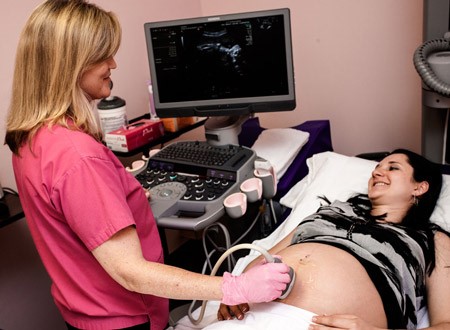
A General Body Ultrasound Exam is a safe and painless procedure which produces pictures of the inside of the body (neck, abdomen, pelvis) using sound waves to create an image, without any radiation.
While PINK Breast Center primarily uses ultrasound to supplement mammograms and to aid in breast biopsies, our technologists are also trained and qualified in body ultrasound. You can schedule your ultrasound appointment in the same comfortable, relaxed setting as you get your annual mammograms.
You will need a prescription from your doctor for a specific body ultrasound. While breast care does not require a prescription, PINK cannot perform general body ultrasounds without a prescription defining the concern to be addressed.
A body exam produces pictures of the inside of the body using sound waves, without ionizing radiation or pain. Ultrasound imaging involves the use of a small transducer (probe) and ultrasound gel placed directly on the skin, which can feel cold. The transducer collects the sounds that bounce back and a computer then uses those sound waves to create an image. Because ultrasound images are captured in real-time, they can show the structure and movement of the body’s internal organs, as well as blood flowing through blood vessels.
Ultrasound imaging is a noninvasive medical test that helps physicians diagnose and treat medical conditions. Body ultrasound displays the images in thin, flat sections of the body. Improvements in Ultrasound technology include three-dimensional (3-D) and (4-D) images.
A special ultrasound technique called Doppler Ultrasound, allows the physician to see and evaluate blood flow through arteries and veins. This is helpful in the abdomen, arms, legs, neck and/or brain, or within organs such as the liver or kidneys.
General Body Ultrasound can be used to evaluate:
- Thyroid
- Soft Tissue Neck
- Abdominal-Liver, Gallbladder, Pancreas, Spleen
- Renal / Bladder
- Transvaginal-Pelvic Organs
- Pelvic-Transabdominal
- Musculoskeletal
- Testicular
- Obstetrical-Biophysical Profiles
- Doppler Exams – Carotid Arteries Doppler, Lower Extremity Arterial Doppler, Lower Venus Doppler, Abdominal Pelvic. Doppler, Aorta and Inferior Vena Cava

How Should I Prepare for an Ultrasound Exam?
Wear comfortable, loose-fitting clothing at the day of your exam. You may need to remove all clothing and jewelry around the area to be examined. You may be asked to wear a gown during the procedure.
Preparation for the procedure will depend on the type of examination you will have. For some scans, your doctor may instruct you not to eat or drink for as many as 12 hours before your appointment. For others, you may be asked to drink up to six glasses of water two hours prior to your exam and avoid urinating, so your bladder is full when the scan begins.
Ultrasound examinations are painless and easily tolerated by most patients. Most ultrasound examinations are completed within 20-30 minutes, although more extensive exams may take up to an hour. When the examination is complete, you may be asked to dress and wait while the ultrasound images are reviewed by a physician radiologist. You can resume your prior activities immediately.
If a follow-up exam is necessary, your doctor will explain why. Sometimes, a follow-up exam is done because a suspicious or questionable finding needs clarification with additional views or a special imaging technique.
What Are the Benefits?
Ultrasound is widely available and extremely safe since it does not use any Ionizing Radiation. Ultrasound scanning gives a clear picture of soft tissues that do not show up well on X-Ray images. Ultrasound provides real-time imaging, making it a good tool for guiding minimally invasive procedures such as Biopsies or Cyst aspiration.
